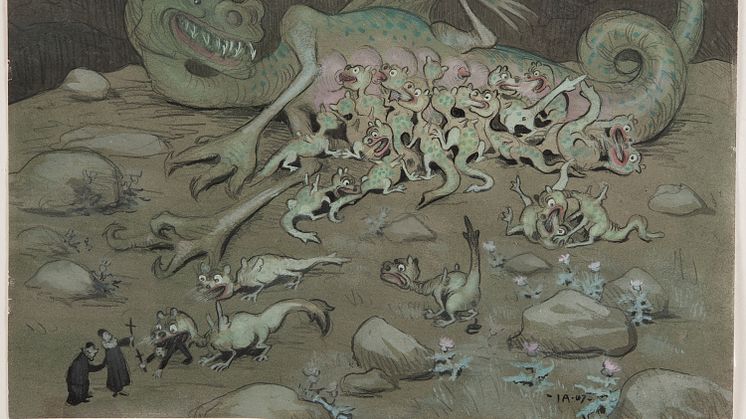
Press release -
New acquisition: Watercolours by Ivar Arosenius
Nationalmuseum has acquired two watercolour paintings showing two different sides of the publicly loved artist Ivar Arosenius. Evil Powers is a jocular personification of evil, depicting a she-dragon with her young. The second work is a sketch for a fairytale series entitled The Caliph’s Golden Bird.Over the years, Nationalmuseum has continuously added works by this artist to its collection.
Ivar Arosenius died of complications resulting from hemophilia on 1 January 1909 at the age of just 30. In his short life he had led a dissolute, bohemian existence, but in later years he had settled down, married, and fathered a daughter, Lillian, whom he worshipped. He left behind a treasure trove of paintings, many of which reflect the circumstances of his life and feature a distinctive, dreamlike, fairytale atmosphere. The majority are small-scale watercolours, in which bizarre and burlesque elements are mixed with seriousness and quiet melancholy. The repertoire of themes includes the eternal riddles of life and death, and questions of good and evil. Some of the works also contain allusions to the seven deadly sins, including lust and gluttony. In the spirit of Bellman and Fredman, Arosenius often preaches a somewhat trite gospel of epicureanism in these works, suggesting that if you have a glass in your hand and a girl on your knee, you can sit back and watch the world go by with gentle indulgence.
Although Arosenius’ talent was recognized early on by the city art museum in his native Gothenburg, Nationalmuseum owned very few of his works for the longest time. Not until a major solo exhibition was staged in 1978 did the museum take the opportunity to enhance its collection with extensive acquisitions from the artist’s descendants. Over the years, these have been continuously supplemented by additional acquisitions. Another two works were purchased in 2014, further highlighting the broad scope of the artist’s oeuvre.
The first, titled Evil Powers, is dated 1907 and depicts a personification of evil in veiled, jocular form. In a sterile cliff landscape surrounded by black rocks, a she-dragon has given birth and is suckling some 20 bickering young reptiles. Some of them, having had their fill, have contentedly begun to explore their surroundings. One is doing its business on the ground, and at bottom left another has sniffed out and sunk its teeth into a black-clad clergyman. The scene plays out in pale green moonlight, which imbues the image with an air of terror.
The second watercolour is very different in nature, its exotic features evoking the fairytale atmosphere of the Arabian Nights. It is one of many sketches and proposals prepared by Arosenius in 1908 for a fairytale series without text entitled The Caliph’s Golden Bird.The story tells of the caliph’s goose, famous for laying golden eggs, which escapes but is caught by a poor peasant boy on whom fortune is smiling. In the end, the boy is granted the hand of the princess and half the kingdom by the grateful caliph.
Nationalmuseum’s purchase of these Arosenius watercolours has been made possible by a generous bequest from Hedda and N.D. Qvist Fund. Nationalmuseum has no budget of its own for new acquisitions, but relies on gifting and financial support from private funds and foundations to enhance its collections of fine art and craft.
Media contact
Ulf Cederlöf, senior curator collections, ulf.cederlof@nationalmuseum.se, +46 8 5195 4402
Hanna Tottmar, press officer: hanna.tottmar@nationalmuseum.se, +46 767 234632
Caption
Ivar Arosenius, Evil Powers, 1907. Photo: Cecilia Heisser/Nationalmuseum
Categories
Nationalmuseum is Sweden’s premier museum of art and design. The collections comprise older paintings, sculpture, drawings and graphic art, and applied art and design up to the present day. The museum building is currently under renovation and scheduled to open again in 2017. In the meantime, the museum will continue its activities through collaborations both in Sweden and abroad as well as temporary exhibitions at the Royal Swedish Academy of Fine Arts, Fredsgatan 12, Stockholm. Nationalmuseum collaborates with Svenska Dagbladet, FCB Fältman & Malmén and Grand Hôtel Stockholm. For more information visit www.nationalmuseum.se.

